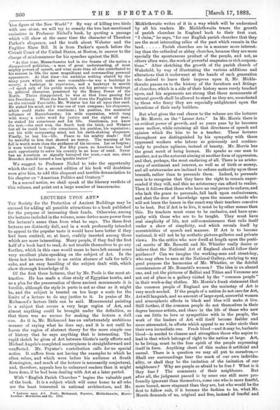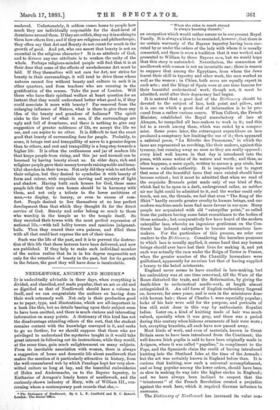LECTURES UPON ART.*
THE Society for the Protection of Ancient Buildings may be excused for adding all possible attractions to a book published for the purpose of increasing their funds. Otherwise, among the lectures included in the volume, some derive more power from the lecturer's name than from what he says. The three first lectures are distinctly dull, and in a work professedly intended to appeal to the popular taste it would have been better if they had been omitted, or, at least, craftily inserted among those which are more interesting. Many people, if they find the first half of a book hard to read, do not trouble themselves to go any further, which in this case would mean to have left unread some very excellent plain-speaking on the subject of Art. In the three last lectures there is an entire absence of talk for talk's sake, and an easy handling of the subject dealt with, which :show thorough knowledge of it.
Of the first three lectures, that by Mr. Poole is the most at- tractive. He has made a close study of Egyptian tombs, and as a plea for the preservation of these ancient monuments it is forcible, although the style in parts is not as clear as it might be, and the subject is treated on too large a scale for the limits of a lecture to do any justice to it. In praise of Mr. Richmond's lecture little can be said. Monumental painting is a subject that covers a very large region of Art, and almost anything could be brought under the definition, so that there was no excuse for making the lecture a dull one. As it is, Mr. Richmond has an unfortunately ambitions manner of saying what he does say, and it is not until he leaves the region of abstract theory for the more simple one of history that he says anything that is interesting. The rapid sketch he gives of Art between Giotto's early efforts and Michael Angelo's completed masterpieces is straightforward and unaffected. Mr. Poynter's contribution calls for no special notice. It suffers from not having the examples to which he often refers, and which were before his audience at South Kensington, and mach of the lecture is necessarily conjectural, and, therefore, appeals less to unlearned readers than it might have done, if he had been dealing with Art at a later period.
With "English Parish Churches" begins the valuable part of the book. It is a subject which will come home to all who are the least interested in national architecture, and Mr.
• Lectures upon Art. Poole. Richmond, Poynter, Micklethwaite, Morris London ; Macmillan and Co. 1893.
Micklethwaite writes of it in a way which will be understood by all his readers. Mr. Micklethwaite traces the growth of parish churches in England back to their first root. "I claim," he says, "for our English parish churches that they are the most interesting relics of the past which remain in the
land Parish churches are in a manner more interest- ing than the cathedral or abbey churches, because they are more specially the spontaneous product of the people, and not, as others often were, the work of powerful magnates or rich corpora- tions." After sketching the growth of the parish church of Wakefield, by way of illustrating the various additions and alterations that it underwent at the hands of each generation who desired to leave their impress upon it, Mr. Mickle- thwaite passes on to the history of the furniture and fittings of churches, which is a side of their history more rarely touched upon, and his arguments are strong that those monuments of natural growth shall be allowed to stand as they are, unmolested by those who fancy they are especially enlightened upon the intentions of their early builders.
But what gives the real charm to the volume are the lectures by Mr. Morris, on the "Lesser Arts." In Mr. Morris there is an evident power of growth, and as years pass by he becomes more mellow, while retaining all that directness of speech and opinion which fits him to be a teacher. These lectures throughout are distinguished by his sympathy with those oppressed workers who labour so grievously and continu- ously to produce ugliness, instead of beauty. Mr. Morris has the great merit of being human. He speaks as one man to another, not as the autocrat aiming at another form of oppression, and that, perhaps, the most enslaving of all. There is an aristo- cracy of sentiment and interest, as well as of birth or money, and all aristocracies are inclined to enforce authority upon those beneath, rather than to persuade them. Indeed, to persuade men is to recognise that they have the right to remain unper- suaded if they will, and this no aristocracy can afford to realise. Then it follows that those who have no real power to enforce, and who lack the grace to persuade, fall back upon exclusiveness, and shut the door of knowledge upon the masses outside who will not learn the lesson in the exact way their teachers conceive to be best. But if Art is to live, it must be by other means than this. Its teachers mast cease to be exclusive, and have sym- pathy with those who are to be taught. They must have real simplicity of life, not self-consciousness that veils itself under a show of simplicity, and which reveals itself by eccentricities of speech and manner. If Art is to become national, it will not be by msthetic picture-galleries and private views. Do the critics who now dwell at length upon the poeti- cal merits of Mr. Rossetti and Mr. Whistler really desire or believe that the National Art of England should follow their guidance? Can we imagine the working-man and street-boy, who may often be seen at the National Gallery, studying to any good purpose the harmonies of Mr. Whistler, or the doleful countenances of Mr. Rossetti's women ? The idea is an absurd one, and yet the pictures of Bellini and Titian and Veronese are not out of place in a gallery visited by the "common people" in their work-a-day clothes. Mr. Morris's frank statement that the common people of England are the mainstay of Art is very much needed. If the people of a nation do not care for Art, Art will languish, and no amount of large-eyed, sorrowful women and atmospheric effects in black and blue will make it live. Still further, if the common people do not themselves in their degree become artists, and share in the life of those who now can see little to love or sympathise with in the people, the work of the leaders of Art will itself become feebler and more attenuated, in efforts which appeal to no wider circle than their own immediate one. Fresh blood—and it may be, barbaric blood—is needed to cleanse and strengthen those who aspire to lead in that which belongs of right to the nation at large. Art, to be living, must be the free spirit of the people expressing itself in form. Anything short of this makes it artificial and unreal. There is a question we may all put to ourselves,— Shall our surroundings bear the mark of our own individu- ality, or shall they be the imitation of the imitation of our neighbours ? Why are people so afraid to be free ? What is it they fear.? The comments of their neighbours. But after all, the judgment passed is by some one still more pro- foundly ignorant than themselves, some one who is more fearful, more bound, more stagnant than they are, but who would be the first to follow snit, if it became the fashion to be, what Mr. Morris demands of us, original and free, instead of fearful and enslaved. Unfortunately, it seldom comes home to people how much they are individually responsible for the dead-level of dreariness around them. If they are selfish, they say it is nothing to them how others live.; and if they are religions and philanthropic, they often say that Art and. Beauty do not count for much in the growth of good. And yet, who can assert that beauty is not an essential in the religious character? It is an attribute of God, and to divorce any one attribute is to weaken the unity of the whole. Perhaps religious-minded people will find that it is at their door that some of the effects of unwholesome Art must be laid. If they themselves will not care for Art, nor strive for beauty in their surroundings, it will tend to drive those whose natures cannot live without beauty and. culture to seek it in other quarters, and from teachers who are cunning in the gratification of the senses. Take the poor of London. Will those who have their spiritual welfare at heart question for an instant that they would understand. better what good is, if they could associate it more with beauty ? Far removed from the -enlarging influence of Nature, what is there to give them any idea of the beauty and grandeur of holiness P The spirit sinks to the level of what it sees, if the surroundings are mgly and full of dreariness, and there is nothing to give any suggestion of greater nobleness of life, we accept the life we tee, and can aspire to no other. It is difficult to test the exact good that beauty of surrounding does for people. Probably, to some, it brings rest and tranquillity of nerve to a greater degree than to others, and rest and tranquillity is a long step towards a higher life. It is often the restlessness and jar of modern life that keeps people from rising, and this jar and turmoil can be lessened by having beauty about us. In older days, rich and religions people gave their money towards raisingnoble and beau- tiful churches in their towns. Not only did they wish to set forth their religion, but they desired to symbolise it with beauty of form and colour, with exquisite carving and mystery of light and shadow. Having built such houses for God, these same people felt that their own homes should be in harmony with them, and not only a tribute to the lower ambitions of men,—to display, to luxury, or even to excess of com- fort. People desired to live themselves at no less perfect development than that which they thought fit for the direct service of God. Beauty and order belong as much to those who worship in the temple as to the temple itself. So they enriched their towns with the most perfect expression of national life,—with tall belfry towers and spacious judgment- halls. Then they reared their own palaces, and filled them with all that could best express the art of their time.
Such was the life of the past, and it is to prevent the destruc- tion of this life that these lectures have been delivered, and now are published. If they help to make each individual member of the nation realise that he is in his degree responsible not only for the retention of beauty in the past, but for its growth in the future, the good they will have done is incalculable.



































 Previous page
Previous page